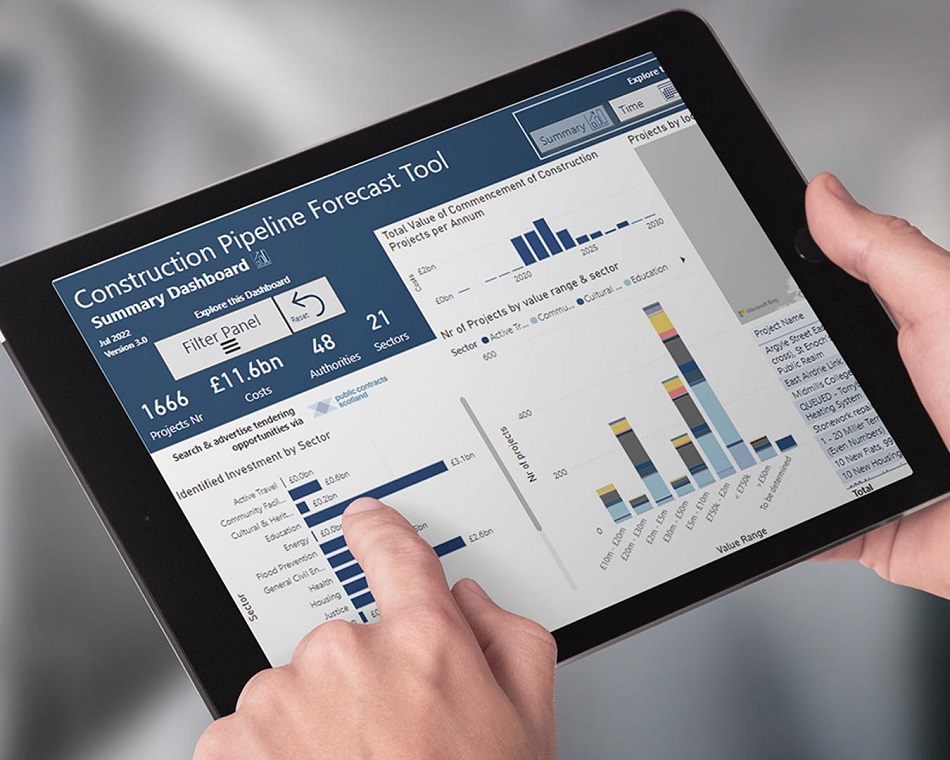Construction Pipeline Forecast Tool marks first year with registrations surge

The number of Scottish businesses registering with the Construction Pipeline Forecast Tool has increased by over 30% to 800 since the pipeline’s last update in January 2022.
Launched in July last year to provide the construction industry with greater clarity and understanding of future public sector construction projects to be built across Scotland, the Construction Pipeline Forecast Tool has now had its half-yearly refresh, with new figures showing more than 1,660 individual projects detailed, a construction pipeline valued at over £11.6 billion and 48 public bodies registered.
Managed by infrastructure body the Scottish Futures Trust (SFT), the Construction Pipeline Forecast Tool was one of the actions coming from the Scottish Construction Leadership Forum’s Recovery Plan, published in October 2020 to support Scotland’s construction industry to recover and rebuild better, and was also a recommendation from the Infrastructure Commission for Scotland in its reports to Scottish Government.
The Pipeline database provides a longer-term view on planned investment up to 2028, with the majority of the forecast spend occurring before 2025. The Pipeline database allows the user to simply and easily look at the data using various criteria that includes the chosen procurement route, the procuring authority, contract value and sector. The types of construction projects include new build, refurbishments, and maintenance across a wide range of sectors including roads, health, education, housing and cultural and heritage.
Of the 1,666 projects, over 50% are below £2 million in value, emphasising the opportunities for small and medium-sized enterprises working in the construction sector.

Peter Reekie, chief executive of the SFT, said: “The registration figure speaks for itself with more and more businesses seeing the real benefits of having free access to knowledge on a future pipeline of work, covering the whole of Scotland.
“There are over 1,660 projects with many more business opportunities and by accessing the site, companies working across the whole of the construction sector can quickly and easily see planned projects, either near to them or in the sectors they specialise in.
“The pipeline is proving to be a vital planning tool for many SMEs, giving them greater insight into future workload where they can increase and or maintain, their investment levels in skills and future training needs.”

Peter Reekie
Jane Thompson, head of Glasgow City Region Programme Management Office, said: “Glasgow City Region welcomes the work which has been undertaken to develop and maintain the Construction Pipeline Forecast Tool.
“This has proven to be a hugely valuable asset to the public and private sector partners across the City Region. We have showcased the Pipeline Forecast Tool in our annual summit with the private sector utility providers and are keen to expand the scope of the data to include wider construction work by utilities’ partners. The Region team is using the data captured by the Tool to estimate the job requirements and associated skills needs of the public sector’s planned investments in the Region.
“This information is key for ensuring effective training provision is in place to meet regional contractors’ business needs, ensuring they are able to compete for these important public sector construction contracts.
“Glasgow City Region is fully supportive of the continued use and future expansion of the use of the Construction Pipeline Forecast Tool in supporting the economic growth and maximising the skills, training, and community benefit opportunities available to our residents.”
Dr Doug Forbes, from Dundee-based Whole Life Consultants Ltd, said: “The Construction Pipeline will be of huge assistance in understanding anticipated future levels of construction activity across Scotland. In turn, that will help with skills forecasting and workforce planning.”

















